Family: Xyelidae
Family common name: xyelid sawflies
Subfamily: Xyelinae
Tribe: Xyelini
Genus: Xyela Dalman, 1819
Subgenera: Xyela, Mesoxyela, Pinicolites
Most phylogenies position Xyelidae as the most primitive family of all Hymenoptera. The xyelids are usually associated with a primitive plant group, coniferousconiferous:
describing a conifer
trees (Ross 1932, Blank and Kramp 2017Blank and Kramp 2017:
Blank SM and Kramp K. 2017. Xyela davidsmithi (Hymenoptera, Xyelidae), a new pine catkin sawfly with an unusual host association from the Sierra Nevada. Proceedings of the Entomological Society of Washington 119 (Special Issue): 703-717.).
Xyela adults are small, less than 5 mm in length. They are somewhat common and the most species-rich genus in the Xyelidae. Xyela feed as larvaelarva:
the immature stage of holometabolous insects
 and adults, generally on the protein-rich pollen of male pine flowers (Smith 1990Smith 1990:
and adults, generally on the protein-rich pollen of male pine flowers (Smith 1990Smith 1990:
Smith DR. 1990. A new Xyela (Hymenoptera: Xyelidae) from western United States. Entomologist's News 101 (1): 9-12., Blank et al. 2013Blank et al. 2013:
Blank SM, Shinohara A, and Altenhofer E. 2013. The Eurasian species of Xyela (Hymenoptera, Xyelidae): taxonomy, host plants, and distribution. Zootaxa 3629 (1): 1-106. https://doi.org/10.11646/zootaxa.3629.1.1, Blank and Kramp 2017Blank and Kramp 2017:
Blank SM and Kramp K. 2017. Xyela davidsmithi (Hymenoptera, Xyelidae), a new pine catkin sawfly with an unusual host association from the Sierra Nevada. Proceedings of the Entomological Society of Washington 119 (Special Issue): 703-717.).
There are 49 described extantextant:
in existence; opposite of extinct
species worldwide, restricted to the Northern Hemisphere. Twenty species occur in North America (Taeger et al. 2010Taeger et al. 2010:
Taeger A, Blank SM, and Liston AD. 2010. World Catalog of Symphyta (Hymenoptera). Zootaxa 2580: 1-1064., Blank et al. 2017Blank et al. 2017:
Blank SM, Kramp K, Smith DR, Sundukov YN, Wei M, and Shinohara A. 2017. Big and beautiful: the Megaxyela species (Hymenoptera, Xyelidae) of East Asia and North America. European Journal of Taxonomy 348: 1-46.).
A key to the North American species of Xyela is included in Burdick 1961Burdick 1961:
Burdick DJ. 1961. A taxonomic and biological study of the genus Xyela Dalman in North America. University of California Publications in Entomology 17 (3): 285-355..
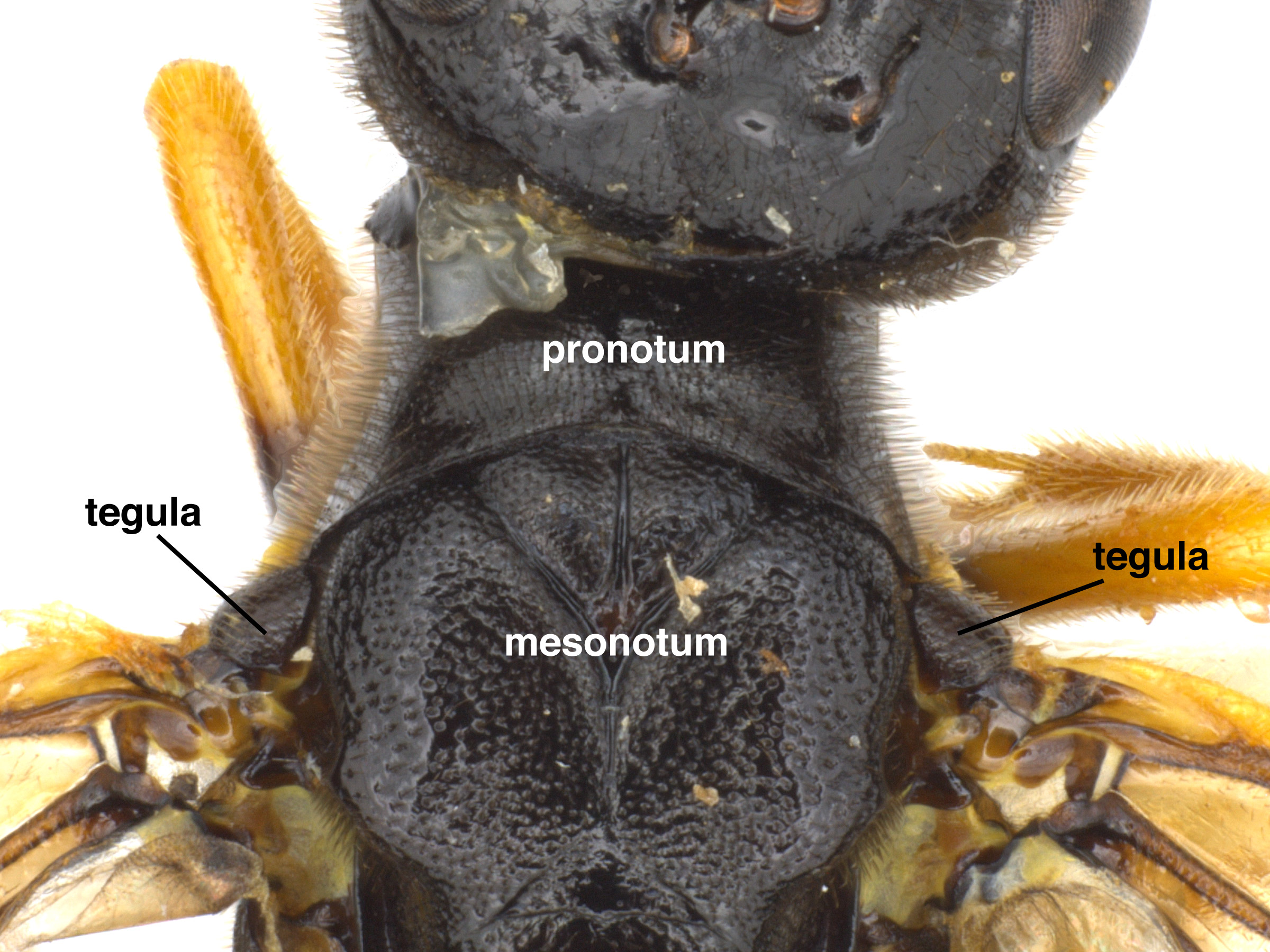 slightly constricted in the center, as seen from above (Goulet 1992Goulet 1992:
slightly constricted in the center, as seen from above (Goulet 1992Goulet 1992: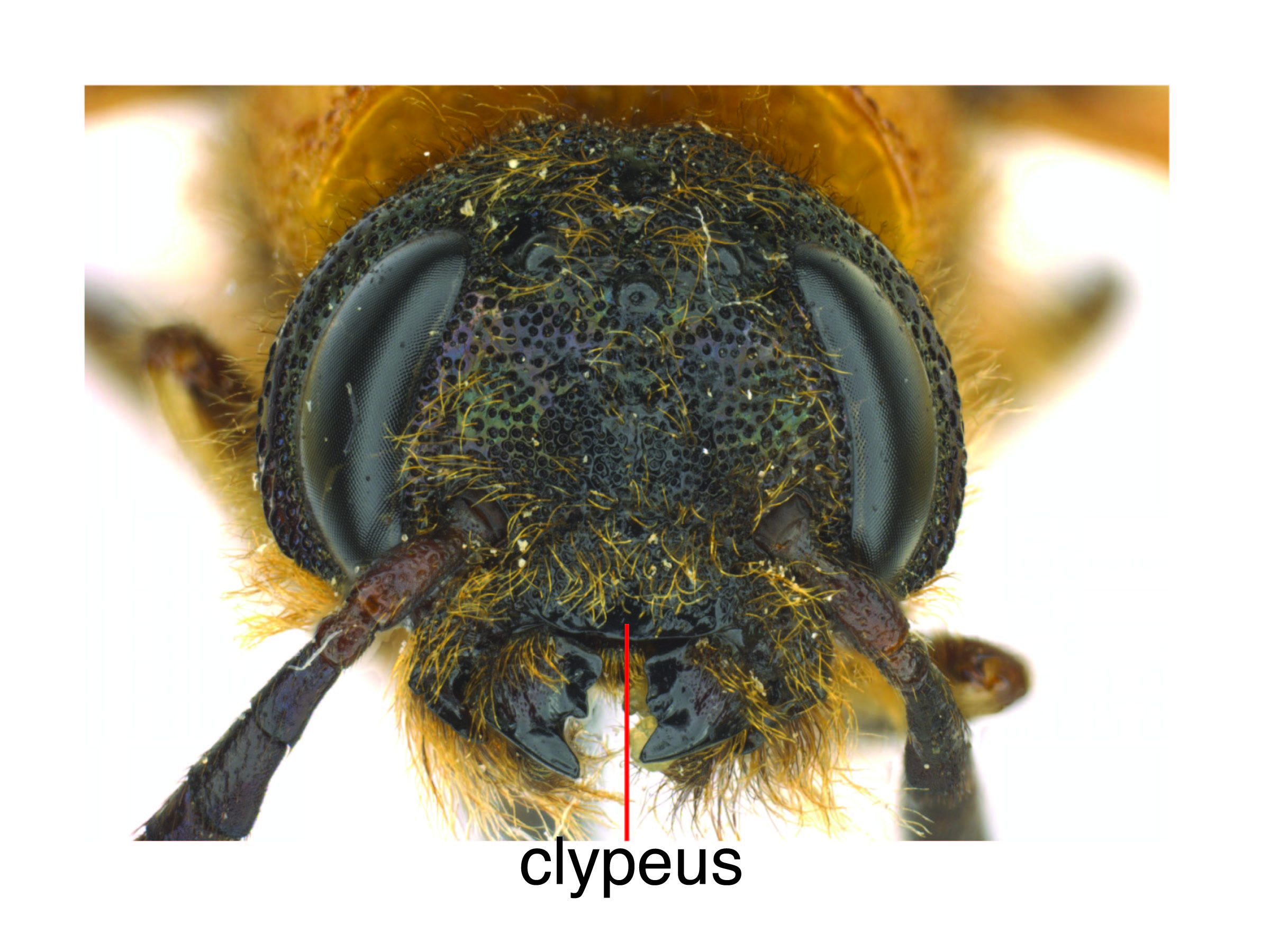 as measured at the basebase:
as measured at the basebase: ; narrower than 3 preceding segments (Burdick 1961Burdick 1961:
; narrower than 3 preceding segments (Burdick 1961Burdick 1961: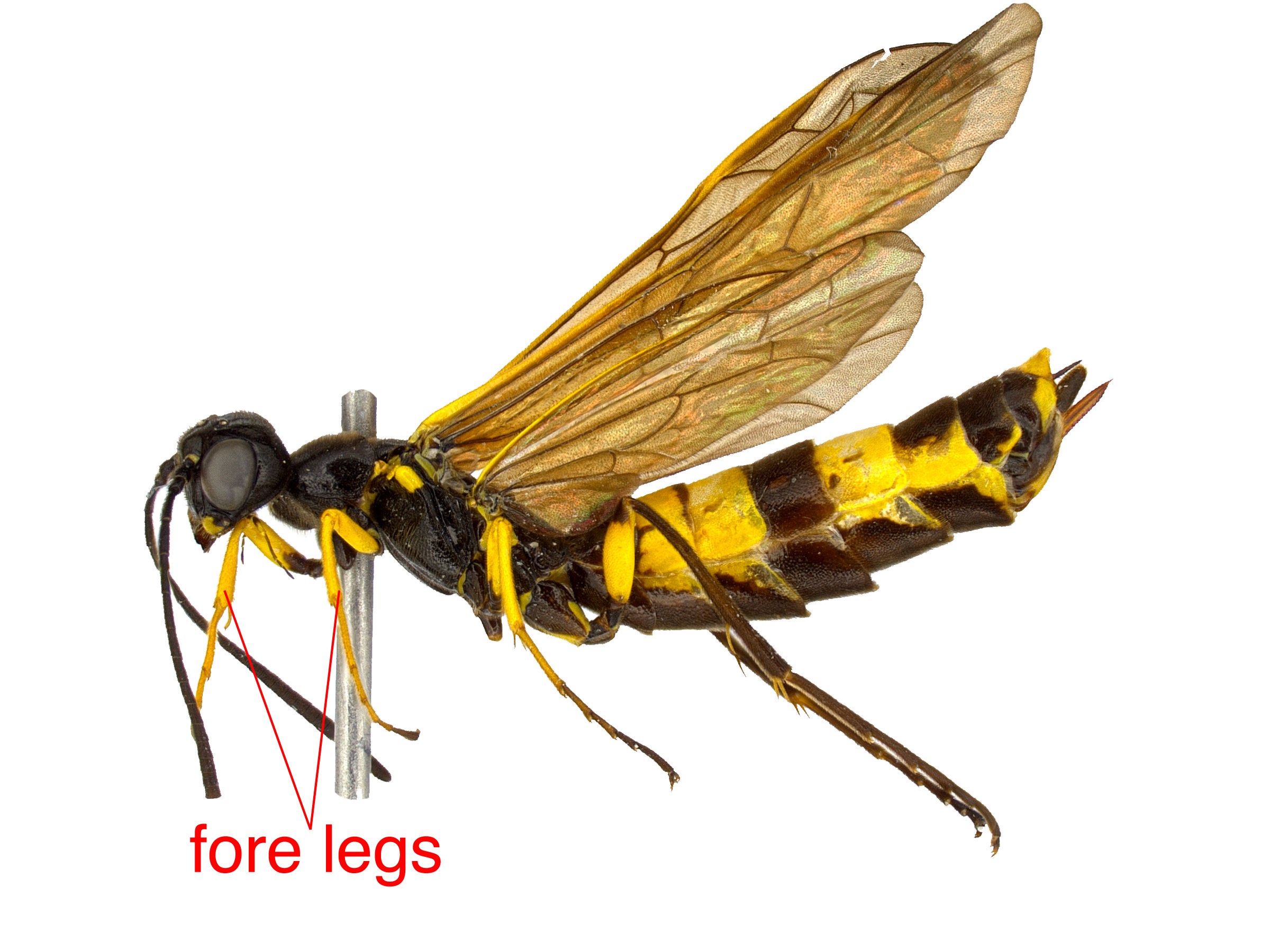 (Goulet 1992Goulet 1992:
(Goulet 1992Goulet 1992: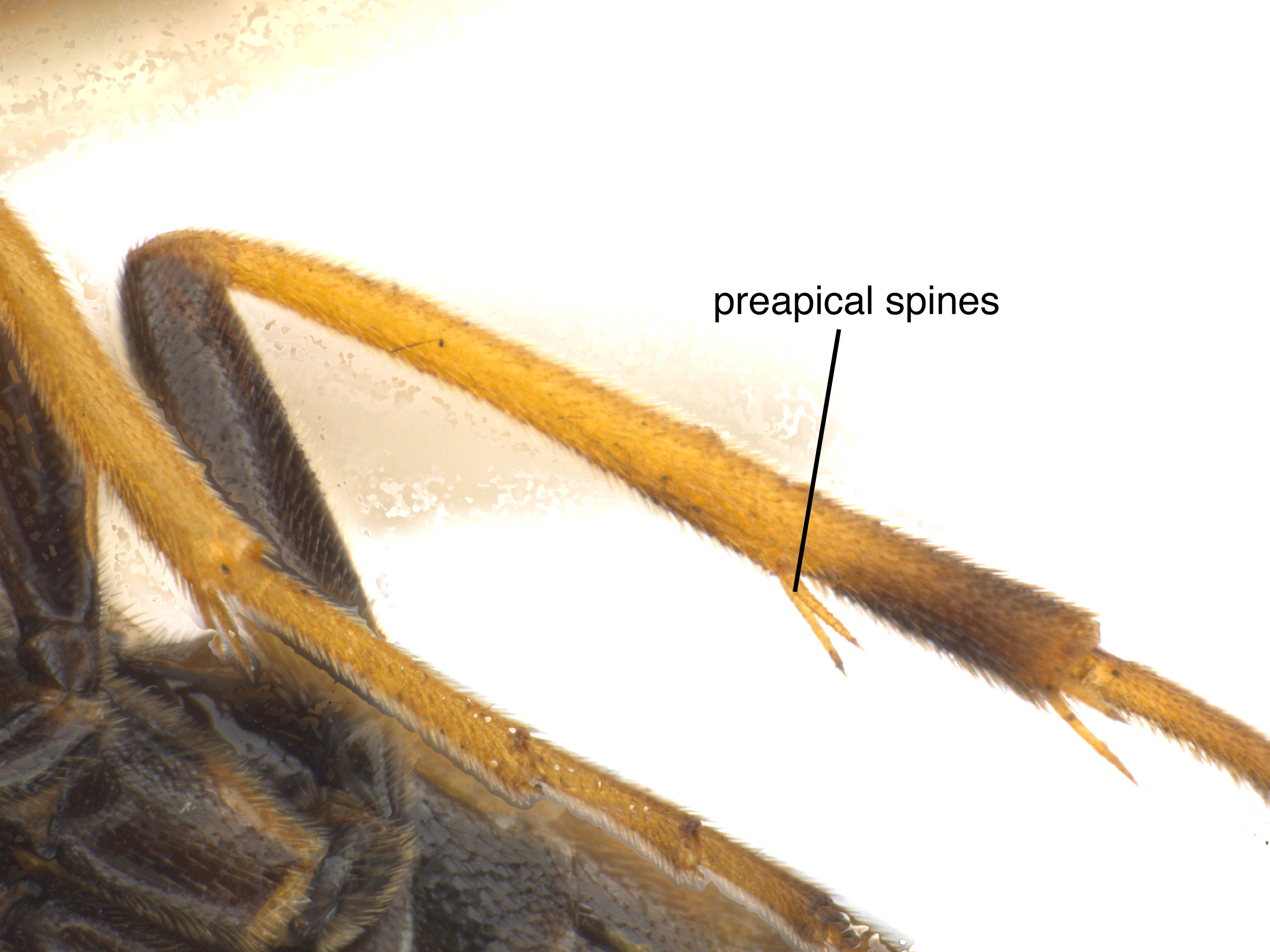 tibial spurs on the mid legmid leg:
tibial spurs on the mid legmid leg: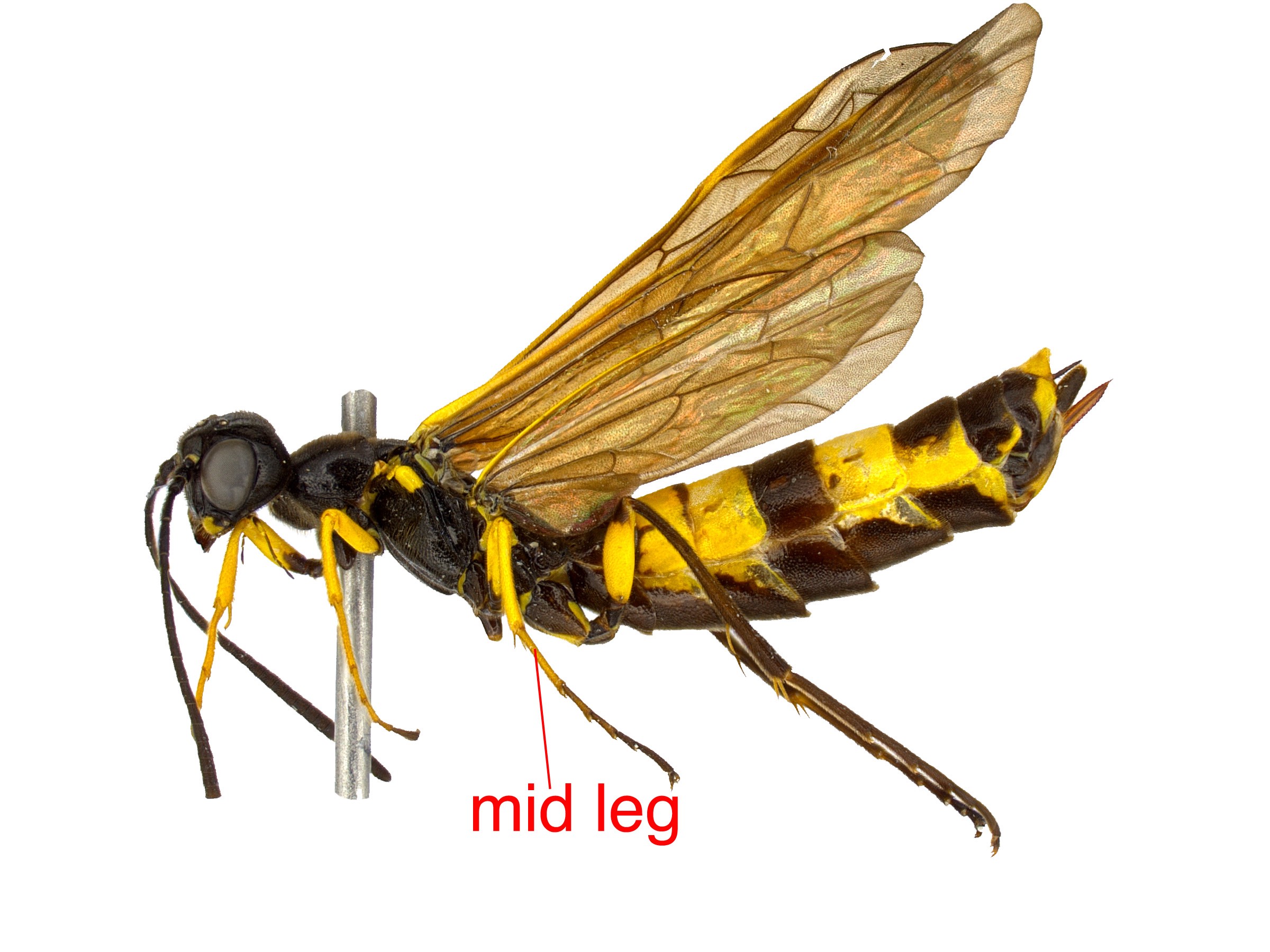 (Goulet 1992Goulet 1992:
(Goulet 1992Goulet 1992: with 12 segments: scapescape:
with 12 segments: scapescape: , pedicelpedicel:
, pedicelpedicel: , and 10 flagellomeres (Burdick 1961Burdick 1961:
, and 10 flagellomeres (Burdick 1961Burdick 1961: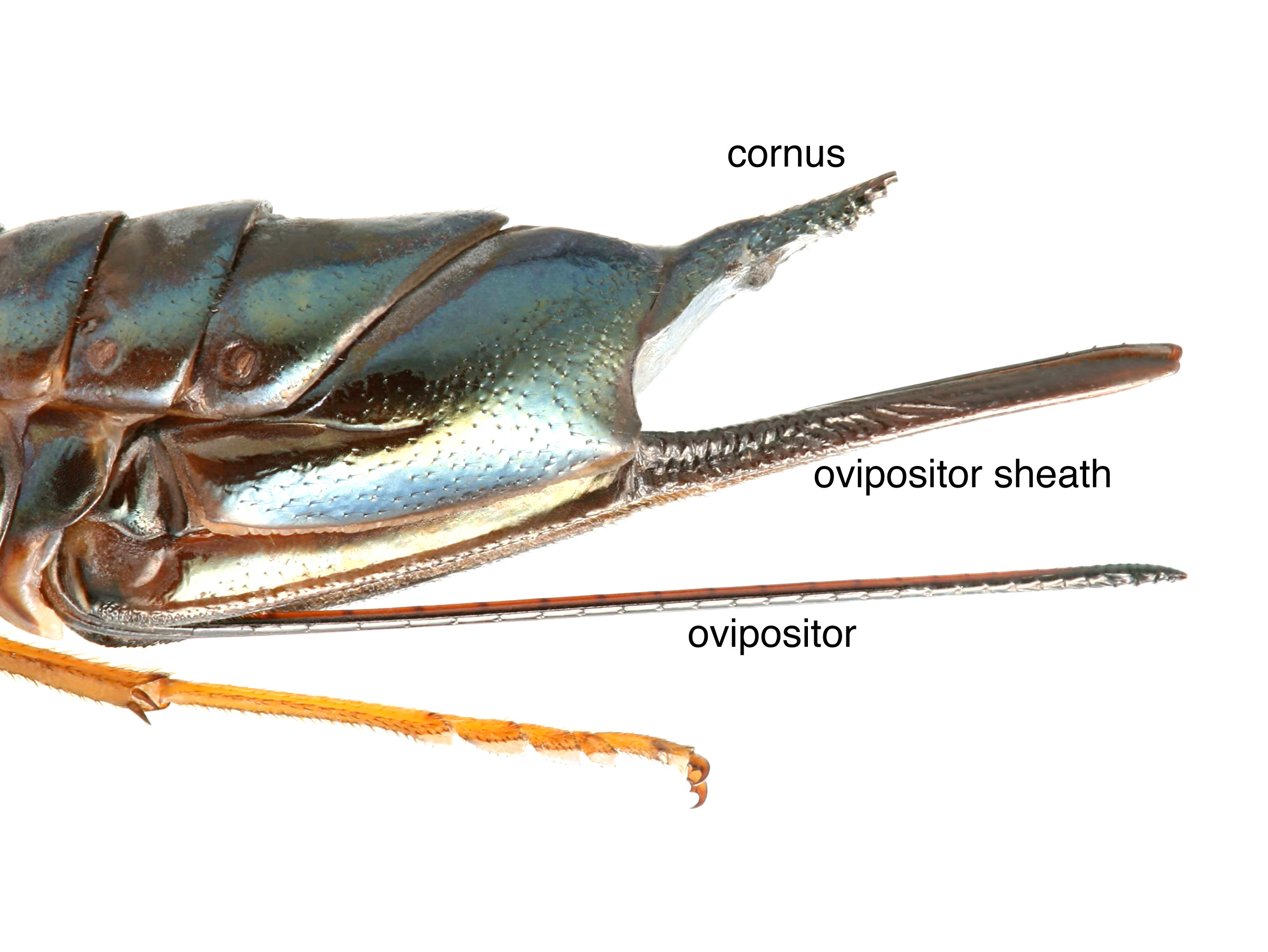 long, measuring between slightly shorter than body length to longer than body length (Burdick 1961Burdick 1961:
long, measuring between slightly shorter than body length to longer than body length (Burdick 1961Burdick 1961: Sc of fore wingfore wing:
Sc of fore wingfore wing: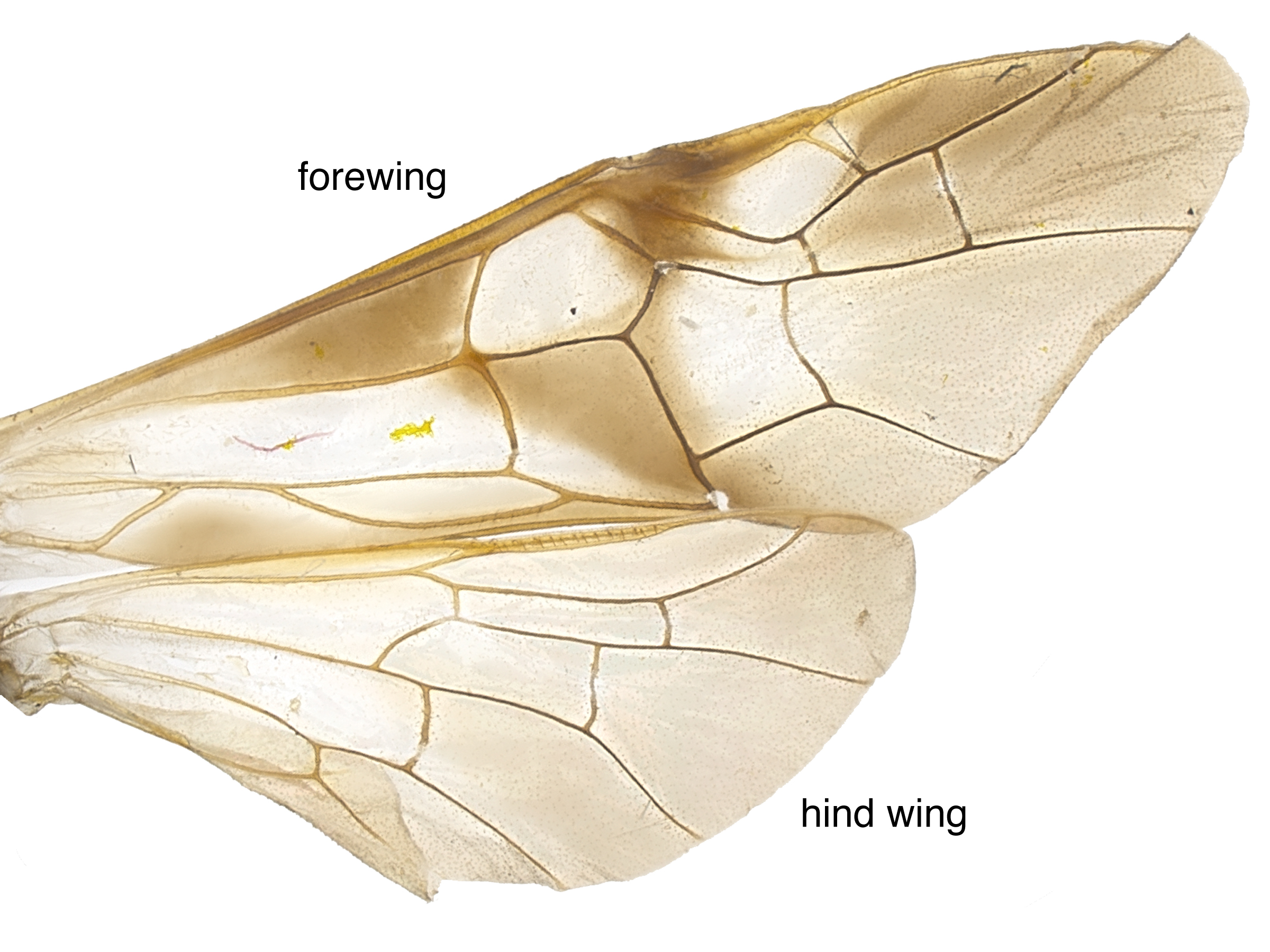 very close, sometimes indistinguishable from veinvein:
very close, sometimes indistinguishable from veinvein: R (Goulet 1992Goulet 1992:
R (Goulet 1992Goulet 1992: located basalbasal:
located basalbasal: of fore wingfore wing:
of fore wingfore wing: measuring twice as long as wide (Goulet 1992Goulet 1992:
measuring twice as long as wide (Goulet 1992Goulet 1992:Xyelidae can be distinguished from other sawfly families by the long ovipositorovipositor:
the female organ that deposits eggs and is used to drill into plant tissue, located at the apex of the abdomen, made up of the lance and lancet
 and the characteristic elongate third antennal segment which is wider than the remaining flagellumflagellum:
and the characteristic elongate third antennal segment which is wider than the remaining flagellumflagellum:
the third section of the antennae that includes all the segments beyond the pedicel; segments of the flagellum are known as flagellomeres
 . Xyela can be confused with other species in the genus. It can be distinguished by the number of antennal segments, the wing venationvenation:
. Xyela can be confused with other species in the genus. It can be distinguished by the number of antennal segments, the wing venationvenation:
the network of veins on a wing
, and small body size (Burdick 1961Burdick 1961:
Burdick DJ. 1961. A taxonomic and biological study of the genus Xyela Dalman in North America. University of California Publications in Entomology 17 (3): 285-355., Goulet 1992Goulet 1992:
Goulet H. 1992. The genera and subgenera of the sawflies of Canada and Alaska: Hymenoptera. Symphyta. The insects and arachnids of Canada. Part 20. Agriculture Canada Publication.).
None. While Xyela feeds on an economically significant plant family, the feeding behavior of the larvaelarva:
the immature stage of holometabolous insects
 does not noticeably damage the tree (Burdick 1961Burdick 1961:
does not noticeably damage the tree (Burdick 1961Burdick 1961:
Burdick DJ. 1961. A taxonomic and biological study of the genus Xyela Dalman in North America. University of California Publications in Entomology 17 (3): 285-355.).
Larvae feed exclusively on Pinus (pine) species. In North America, the recorded host species are P. contorta (lodgepole pine), P. cembra (Swiss pine), P. strobus (eastern white pine), P. ponderosa (ponderosa pine), P. sabiniana (foothill pine), P. virginiana (Virginia pine), P. palustris (longleaf pine), P. elliottii (slash pine), P. monophylla (singleleaf pinyon), P. taeda (loblolly pine), P. echinata (shortleaf pine), P. mugo (mountain pine), P. coulteri (Coulter pine), P. muricata (bishop pine), P. banksiana (jack pine), P. radiata (Monterey pine), and P. jeffreyi (Jeffrey pine) (Smith 1978Smith 1978:
Smith DR. 1978. Suborder Symphyta (Xyelidae, Parachexyelidae, Parapamphiliidae, Xyelydidae, Karatavitidae, Gigasiricidae, Sepulcidae, Pseudosiricidae, Anaxyelidae, Siricidae, Xiphydriidae, Paroryssidae, Xyelotomidae, Blasticotomidae, Pergidae). Hymenopterorum Catalogus 14: 1-193., Blank and Kramp 2017Blank and Kramp 2017:
Blank SM and Kramp K. 2017. Xyela davidsmithi (Hymenoptera, Xyelidae), a new pine catkin sawfly with an unusual host association from the Sierra Nevada. Proceedings of the Entomological Society of Washington 119 (Special Issue): 703-717.). All Old-World species and the majority of North American species are monophagous (Blank et al. 2017Blank et al. 2017:
Blank SM, Kramp K, Smith DR, Sundukov YN, Wei M, and Shinohara A. 2017. Big and beautiful: the Megaxyela species (Hymenoptera, Xyelidae) of East Asia and North America. European Journal of Taxonomy 348: 1-46.).
Adults feed on pollen from many sources, including Salix sp. (willow), Alnus sp. (alder), and Betula sp. (birch) (Smith 1990Smith 1990:
Smith DR. 1990. A new Xyela (Hymenoptera: Xyelidae) from western United States. Entomologist's News 101 (1): 9-12.).
The female uses the elongate ovipositorovipositor:
the female organ that deposits eggs and is used to drill into plant tissue, located at the apex of the abdomen, made up of the lance and lancet
 to deposit eggs into developing male cones. Emerged larvaelarva:
to deposit eggs into developing male cones. Emerged larvaelarva:
the immature stage of holometabolous insects
 begin to feed on only pollen inside pollen sacs at the basebase:
begin to feed on only pollen inside pollen sacs at the basebase:
the beginning or most proximal area of any structure
of the sporophylls, and consuming the sporophylls as the larvaelarva:
the immature stage of holometabolous insects
 mature. Though they live inside the cone, they are not borers, and instead move among the sporophylls as the cone grows and opens. The larvaelarva:
mature. Though they live inside the cone, they are not borers, and instead move among the sporophylls as the cone grows and opens. The larvaelarva:
the immature stage of holometabolous insects
 usually reach maturity right before the time of pollen dispersal from the cone, where they then fall to the ground to overwinter and pupate (Burdick 1961Burdick 1961:
usually reach maturity right before the time of pollen dispersal from the cone, where they then fall to the ground to overwinter and pupate (Burdick 1961Burdick 1961:
Burdick DJ. 1961. A taxonomic and biological study of the genus Xyela Dalman in North America. University of California Publications in Entomology 17 (3): 285-355., Yates and Smith 2009Smith 2009:
Smith DR. 2009. An obscure sawfly, Kerita fidala Ross (Hymenoptera: Tenthredinidae), new to Virginia, a leafminer of Virginia bluebell, Mertensia virginica (l.) Pers. Ex link (Boraginaceae). Banisteria 33: 53.).
One rare species, X. gallicaulis, does not feed inside the cones and instead is a gall-inducer of young pine shoots. The gall form is elongate and looks like a swollen shoot. Gall formation does not cause mortality of the growing shoot. The larvalarva:
the immature stage of holometabolous insects
 feeds on the stem tissue of the gall, then bores out of the gall to drop to the ground and pupate (Yates and Smith 2009Smith 2009:
feeds on the stem tissue of the gall, then bores out of the gall to drop to the ground and pupate (Yates and Smith 2009Smith 2009:
Smith DR. 2009. An obscure sawfly, Kerita fidala Ross (Hymenoptera: Tenthredinidae), new to Virginia, a leafminer of Virginia bluebell, Mertensia virginica (l.) Pers. Ex link (Boraginaceae). Banisteria 33: 53.).
Xyela is most often univoltineunivoltine:
describing an insect with a life cycle of one generation per year
, with the exception of X. gallicaulis which has a life cycle of two years (Yates and Smith 2009Smith 2009:
Smith DR. 2009. An obscure sawfly, Kerita fidala Ross (Hymenoptera: Tenthredinidae), new to Virginia, a leafminer of Virginia bluebell, Mertensia virginica (l.) Pers. Ex link (Boraginaceae). Banisteria 33: 53.). Adults also feed on pollen during their flight period (Greenbaum 1974Greenbaum 1974:
Greenbaum HN. 1974. A new Xyela (Hymenoptera: Xyelidae) from Florida. The Florida Entomologist 57 (1): 104-106.).
World: Xyela is widespread in Europe, Asia, and North America. (Taeger et al. 2010Taeger et al. 2010:
Taeger A, Blank SM, and Liston AD. 2010. World Catalog of Symphyta (Hymenoptera). Zootaxa 2580: 1-1064.). One species is endemicendemic:
both native and unique to a particular region
to the island of Taiwan (Blank et al. 2017Blank et al. 2017:
Blank SM, Kramp K, Smith DR, Sundukov YN, Wei M, and Shinohara A. 2017. Big and beautiful: the Megaxyela species (Hymenoptera, Xyelidae) of East Asia and North America. European Journal of Taxonomy 348: 1-46.).
North America: The range of Xyela largely follows distributional patterns of pine forests. In North America, their range extends from the Sonoran and Chihuahua deserts of Mexico and southwest United States, north through the Rocky, Sierra, and Cascade Mountains in the west, almost all of western and southern Canada, through the northern Midwest, along the East Coast down through the Southeast (Burdick 1961Burdick 1961:
Burdick DJ. 1961. A taxonomic and biological study of the genus Xyela Dalman in North America. University of California Publications in Entomology 17 (3): 285-355.).
Map data from: GBIF.org (26 June 2019) GBIF Occurrence Download Xyela
Details about data used for maps can be found here.